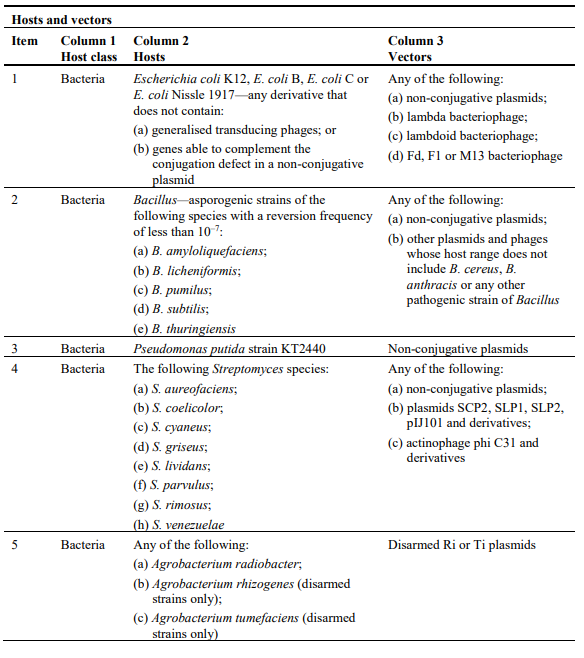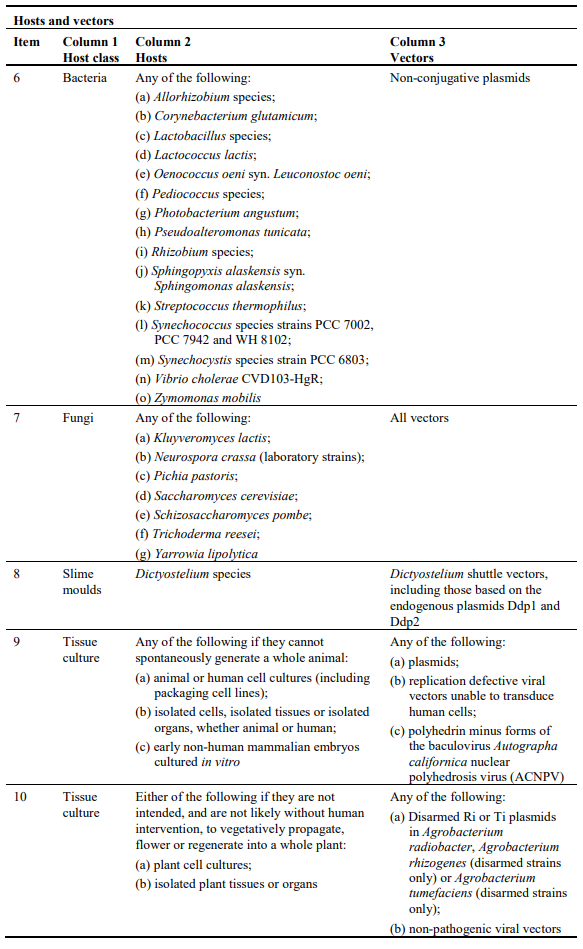Host Selection Criteria
Narrow down the list of candidates by asking yourself the following questions (in this order):
1. Which species can you legally work with in your current facility?
Start with the national law that applies to your jurisdiction, then check state law and local laws in case they also apply. If you’re lucky, your country will have a dedicated national regulator that you can contact to help with navigating the legislation and managing certification.
In Australia the regulator is the OGTR and the legislation is the Gene Technology Regulations (2001) based on the Gene Technology Act (2000)
These laws will be facility specific and often require you to comply with certain certification guidelines to prevent rogue GMO escape. In Australia these are collectively known as the “Physical Certification Guidelines”. According to the OGTR: “PC facilities are classified according to levels of stringency of measures for containing GMOs. The classifications related to the structural integrity of buildings and equipment uses as well as to the handling practices employed by those working in the facility. PC level 1 (PC1) facilities are used to contain organisms posing the lowest risk to human health and the environment. PC level 4 (PC4) facilities provide the most secure and stringent containment conditions.”
If you want to do anything classified as Genetic Modification (even those listed as exempt dealings) in Australia, you must have at least a PC1 facility to ensure there is no ‘intentional release of a GMO into the environment’.
Some regions of the world have more specific or lax laws and I put the responsibility solely on you to discover which laws apply in your jurisdiction. Be sure to research well, unless you want government agents turning up at your door. Consider this my warning to you: Not everyone thinks genetically modifying stuff in your basement is cool.
List of species considered ‘exempt dealings’ by the Australian Government. Coincidentally, this is a generally good list of potential hosts and vectors that you could consider using for your synthetic biology work. If you’re blessed with a PC2+ facility, you may have a wider range of potential hosts to explore - consult the legislation!
Page 3/5 of the OGTR’s “Types of dealings with GMOs classified as Exempt Dealings”
Page 4/5 of the OGTR’s “Types of dealings with GMOs classified as Exempt Dealings”
2. Which species can you easily culture in your current facility?
In order to work with a cell type, you need to be able to sufficiently replicate the natural environment to induce healthy growth and replication.
Culturing can range from childishly easy to devilishly hard, I would highly recommend that any beginner synthetic biologists steer clear of hosts that are tricky to culture.
Mammalian cell work is generally considered far harder than bacterial/yeast work. If you choose to work with mammalian cells you should definitely try get access to a biosafety cabinet.
3. Which species best matches the ambitions of your project?
Ask yourself exactly what you wish to achieve with your project.
Choose the lowest-order organism you possibly can for the experiment.
The various lab strains of E. coli and Yeast will suffice for almost everything you can attempt with these protocols. They’re also efficient, quick to grow and well documented.
If you need to work with Mammalian cells, aim to minimise the number of inputs required to maintain the culture while still meeting your ambitions. Reagents can be prohibitively expensive.
4. Do not pick a complex, multi-cellular target for modification.
Regardless of which laws apply in your area, the most complex organism you can ethically work with (without extreme oversight) is C. elegans. Leave the modification of complex lifeforms to the peer-scrutinised experts.
It is okay to examine and sample genes from complex multicellular organisms to try gain insight into how they function, there is a lot to be learned from genomic and proteomic analysis.
Keep in mind that there are also ethical rules in place for the proper ways to take a sample without causing injury.
If you choose to examine, do not proceed to modification.
However, the inherent complexity of these systems will challenge you to gain any meaningful data from explorations in modification.
Stick to systems where cause and effect can be clearly linked, without confounding variables.
Plasmids in single-celled organisms are the ideal tool.
Maybe in our lifetime we’ll understand the nature of DNA/RNA/Proteins to such an extent that you can use these skills to modify higher-order organisms.
Until then, DON’T.



